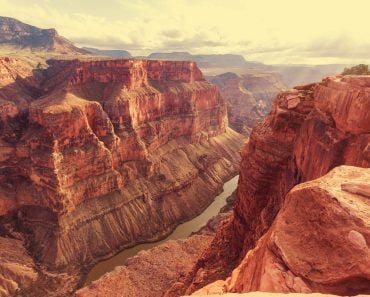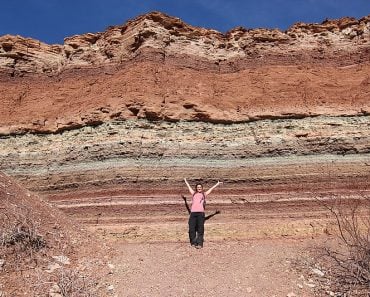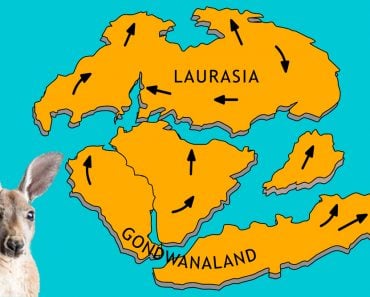Table of Contents (click to expand)
Ventifacts are rocks that have been shaped by the wind. They can be found in flat or arid expanses of land where there is a moderate amount of sand or blowing snow. Ventifacts come in all shapes and sizes, from large rocky outcroppings to single stones. The most important prerequisite for the development of ventifacts is persistent wind that generally moves in the same direction.
If you’ve spent a decent amount of time exploring the natural world, you understand that change takes time. Geologic scales can be hard to comprehend for humans whose lifetimes rarely exceed a single century. Imagine looking down into the Grand Canyon—estimated to be about 70 million years old—which was carved millimeter by millimeter in response to the simple flow of water.
Yes, the natural forces of the world have changed our planet in countless ways, from earthquakes and floods that can shape the landscape overnight to the glacially slow forces that carve mountains, canyons, valleys and the topography of the ocean floor. But what about natural forces working on a much smaller scale, perhaps even on a single piece of rock?
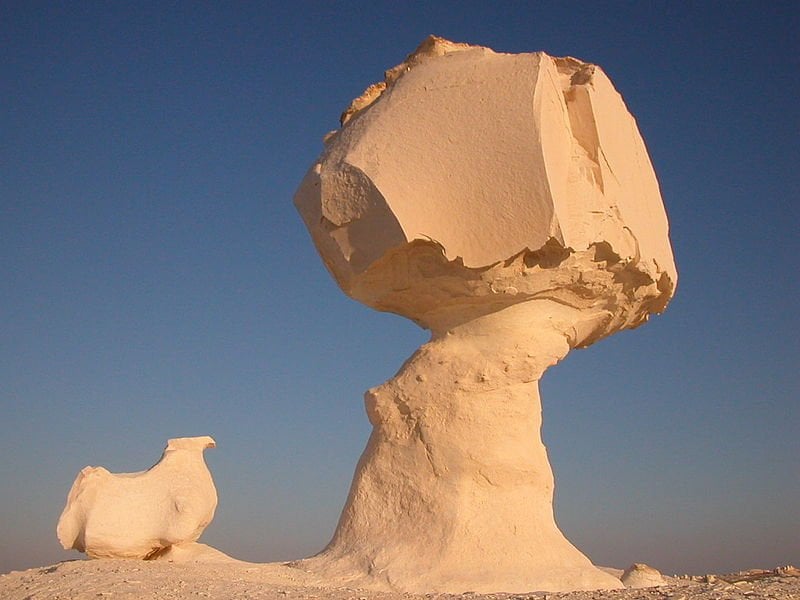
This particular natural phenomenon has stumped and mystified people around the world for generations—rock formations that appear to be carved with intention, too perfect to be shaped by anything other than humans…. or perhaps aliens!
As cool as it would be to discover alien life through their aesthetic reshaping of our environment, these rock formations do have a name—ventifacts—as well as a fascinating story to tell.
Recommended Video for you:
What’s A Ventifact?
When simply defined, a ventifact is any piece of rock that has been shaped, pitted, grooved or striated by sand or ice crystals blown by the wind. In fact, the Latin translation of “ventifact” is “make by wind”. Such formations, both large and small, are usually found in relatively flat or arid expanses of land, where there is a moderate amount of sand or blowing snow, but not an overabundance.
Ventifacts come in all shapes and sizes, from large rocky outcroppings that resemble mushrooms or surreal statues, to single stones you can pick up in your hand. When a stone stays in the same place for decades, centuries, or even millennia, the movement of the wind will gradually shape the various facets or sides of the rock. The most important prerequisite for the development of these rock formations is persistent wind that generally moves in the same direction, and has a ready supply of an abrasive material (i.e., sand) to carry along with it.
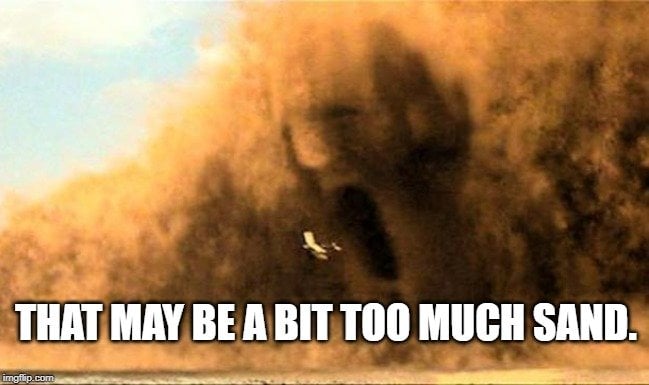
What many people are so mystified by about ventifacts, particularly larger formations in deserts or other barren environments, is the often “top-heavy” appearance. As the image above shows, the rock seems to be worn down more at the bottom than at the top. As mentioned above, having an adequate amount of abrasive material is essential for the formation of ventifacts is important, but remember, sand and ice crystals do have some amount of weight to them. As these material are blown across a tundra or a desert landscape, the wind will bounce them along the ground, but they aren’t perpetually swirling in the air. Most windblown sand and ice will move forward at around 1-2 feet in the air.
For rock formations that are significantly taller than that, the lower portions will be worn away sooner by the frictional forces of the sand or ice crystals, leaving the “top-heavy” appearance to these rocks.
What Secrets Do Ventifacts Hold?
Aside from their somewhat mysterious appearance, ventifacts can also tell about the history of a certain area, particularly on ventifacts with more than one facet. The specificities of the process go beyond the scope of this article, but reading the striations and angles on the stone faces can give some indication of paleo-wind patterns, which provides clues to weather and climate changes in the past.
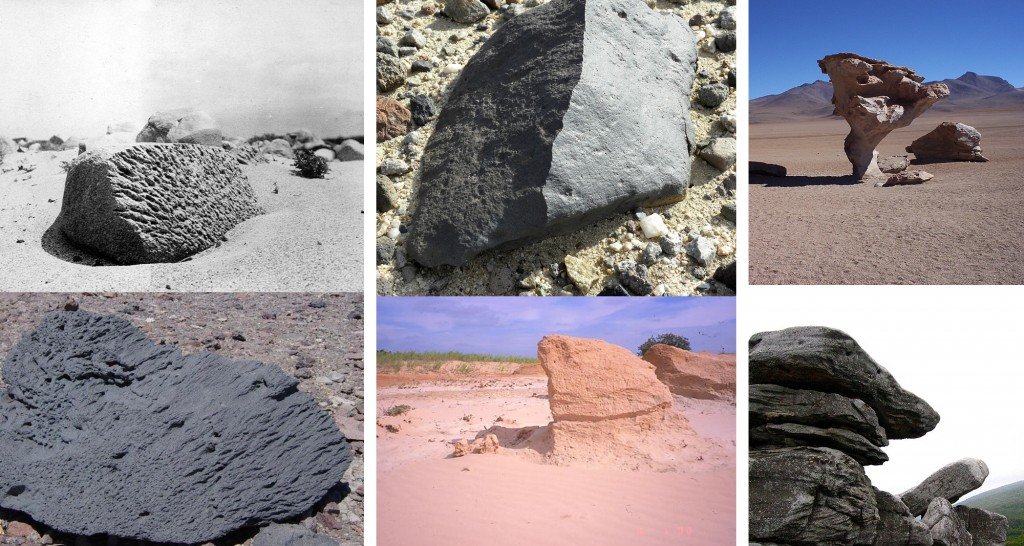
Not all ventifacts are massive rocky mushrooms or bizarre shapes on exposed hillsides; some are simply large stones partially buried in the earth, unmoved for millennia. Ventifacts with three faces are quite common, and are called dreikanters, where three exposed sides are clearly windblown and shaped, while a fourth side is buried in the earth.
There can be different textures to ventifacts, depending on the materials involved, the severity of the wind, the duration of formation, and various other factors. When a grain of sand smashes into a softer sedimentary rock face, it forms a tiny impact crater, and will often stay there. Over time, as wind continues to blow over the facet, it begins to move the piece of sand, wiggling it in place until it begins to dig out a small hole around itself. Decades or centuries later, those minuscule impact craters will have taken on a pockmarked appearance. This can help researchers study the types of rock the sand came from—and where. Different compositions of rock tend to have different textural patterns, another interesting and aesthetically pleasing element of ventifacts. Some boast undulating patterns like a washboard, while others have long tubes or flutes carved out over centuries by a few windblown grains of sand!
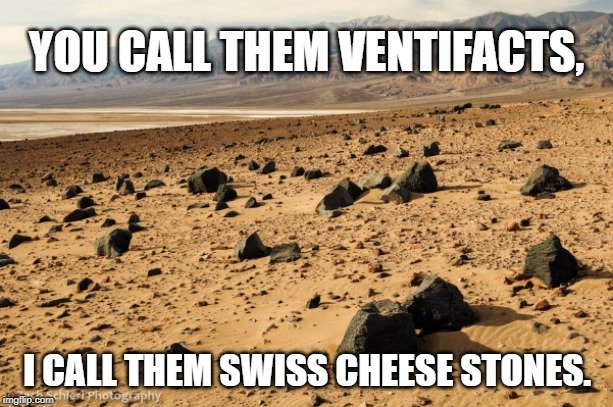
At the top of this article, it was mentioned that sand isn’t the only culprit in the formation of ventifacts. Ice crystals are often thought of as snowflakes, which melt so quickly and aren’t typically considered abrasive. However, once the temperature of ice crystals drops to 30 or 40 degrees below zero, they become hard as crystal, and more than able to cut their way through solid stone if there’s a healthy breeze behind them! In the barren reaches of Antarctica, magnificent valleys of ventifacts have been found, largely untouched for millennia, which again help researchers study climate patterns and wind directions of the past.
Finally, ventifacts aren’t even restricted to our home planet; similarly shaped and textured rocks have been found on the surface of Mars, and actually posed a threat to the NASA rover due to the incredibly sharp angles of the facets, which have been honed to a razor’s edge by the Martian wind over the course of millions of years! Just like they do on Earth, these martian ventifacts act like weathervanes for past wind and weather patterns on the red planet.

A Final Word
While the scientific significance of ventifacts isn’t widely applicable to many fields, they are a spectacle to see in person, and a good reminder that our world is used to small, incremental changes. The drastic shifts currently being made to the planet, driven by mankind’s need for resources, are unlike anything we’ve ever seen before. Ventifacts serve as a testament to history, and a subtle warning for the future!
References (click to expand)
- Knight, J. (2008, January). The environmental significance of ventifacts: A critical review. Earth-Science Reviews. Elsevier BV.
- D PlanetGeomorpho —. Ventifacts on Earth and Mars. WordPress.com
- Ventifacts—sandblast from the past - New Zealand Geographic. New Zealand Geographic
- What is a Ventifact? - WorldAtlas. worldatlas.com
- Ventifact - Wikipedia. Wikipedia




